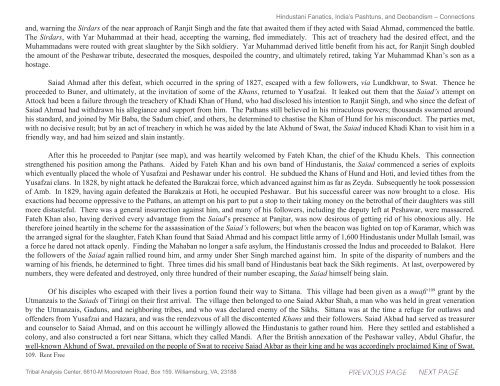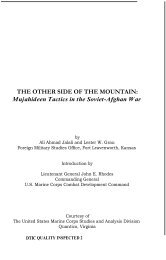hindustani fanatics, india's pashtuns, and deobandism â connections
hindustani fanatics, india's pashtuns, and deobandism â connections
hindustani fanatics, india's pashtuns, and deobandism â connections
- No tags were found...
Create successful ePaper yourself
Turn your PDF publications into a flip-book with our unique Google optimized e-Paper software.
Hindustani Fanatics, India’s Pashtuns, <strong>and</strong> Deob<strong>and</strong>ism – Connections<strong>and</strong>, warning the Sirdars of the near approach of Ranjit Singh <strong>and</strong> the fate that awaited them if they acted with Saiad Ahmad, commenced the battle.The Sirdars, with Yar Muhammad at their head, accepting the warning, fled immediately. This act of treachery had the desired effect, <strong>and</strong> theMuhammadans were routed with great slaughter by the Sikh soldiery. Yar Muhammad derived little benefit from his act, for Ranjit Singh doubledthe amount of the Peshawar tribute, desecrated the mosques, despoiled the country, <strong>and</strong> ultimately retired, taking Yar Muhammad Khan’s son as ahostage.Saiad Ahmad after this defeat, which occurred in the spring of 1827, escaped with a few followers, via Lundkhwar, to Swat. Thence heproceeded to Buner, <strong>and</strong> ultimately, at the invitation of some of the Khans, returned to Yusafzai. It leaked out them that the Saiad’s attempt onAttock had been a failure through the treachery of Khadi Khan of Hund, who had disclosed his intention to Ranjit Singh, <strong>and</strong> who since the defeat ofSaiad Ahmad had withdrawn his allegiance <strong>and</strong> support from him. The Pathans still believed in his miraculous powers; thous<strong>and</strong>s swarmed aroundhis st<strong>and</strong>ard, <strong>and</strong> joined by Mir Baba, the Sadum chief, <strong>and</strong> others, he determined to chastise the Khan of Hund for his misconduct. The parties met,with no decisive result; but by an act of treachery in which he was aided by the late Akhund of Swat, the Saiad induced Khadi Khan to visit him in afriendly way, <strong>and</strong> had him seized <strong>and</strong> slain instantly.After this he proceeded to Panjtar (see map), <strong>and</strong> was heartily welcomed by Fateh Khan, the chief of the Khudu Khels. This <strong>connections</strong>trengthened his position among the Pathans. Aided by Fateh Khan <strong>and</strong> his own b<strong>and</strong> of Hindustanis, the Saiad commenced a series of exploitswhich eventually placed the whole of Yusafzai <strong>and</strong> Peshawar under his control. He subdued the Khans of Hund <strong>and</strong> Hoti, <strong>and</strong> levied tithes from theYusafzai clans. In 1828, by night attack he defeated the Barakzai force, which advanced against him as far as Zeyda. Subsequently he took possessionof Amb. In 1829, having again defeated the Barakzais at Hoti, he occupied Peshawar. But his successful career was now brought to a close. Hisexactions had become oppressive to the Pathans, an attempt on his part to put a stop to their taking money on the betrothal of their daughters was stillmore distasteful. There was a general insurrection against him, <strong>and</strong> many of his followers, including the deputy left at Peshawar, were massacred.Fateh Khan also, having derived every advantage from the Saiad’s presence at Panjtar, was now desirous of getting rid of his obnoxious ally. Hetherefore joined heartily in the scheme for the assassination of the Saiad’s followers; but when the beacon was lighted on top of Karamar, which wasthe arranged signal for the slaughter, Fateh Khan found that Saiad Ahmad <strong>and</strong> his compact little army of 1,600 Hindustanis under Mullah Ismail, wasa force he dared not attack openly. Finding the Mahaban no longer a safe asylum, the Hindustanis crossed the Indus <strong>and</strong> proceeded to Balakot. Herethe followers of the Saiad again rallied round him, <strong>and</strong> army under Sher Singh marched against him. In spite of the disparity of numbers <strong>and</strong> thewarning of his friends, he determined to fight. Three times did his small b<strong>and</strong> of Hindustanis beat back the Sikh regiments. At last, overpowered bynumbers, they were defeated <strong>and</strong> destroyed, only three hundred of their number escaping, the Saiad himself being slain.Of his disciples who escaped with their lives a portion found their way to Sittana. This village had been given as a muafi *109 grant by theUtmanzais to the Saiads of Tiringi on their first arrival. The village then belonged to one Saiad Akbar Shah, a man who was held in great venerationby the Utmanzais, Gaduns, <strong>and</strong> neighboring tribes, <strong>and</strong> who was declared enemy of the Sikhs. Sittana was at the time a refuge for outlaws <strong>and</strong>offenders from Yusafzai <strong>and</strong> Hazara, <strong>and</strong> was the rendezvous of all the discontented Khans <strong>and</strong> their followers. Saiad Akbad had served as treasurer<strong>and</strong> counselor to Saiad Ahmad, <strong>and</strong> on this account he willingly allowed the Hindustanis to gather round him. Here they settled <strong>and</strong> established acolony, <strong>and</strong> also constructed a fort near Sittana, which they called M<strong>and</strong>i. After the British annexation of the Peshawar valley, Abdul Ghafur, thewell-known Akhund of Swat, prevailed on the people of Swat to receive Saiad Akbar as their king <strong>and</strong> he was accordingly proclaimed King of Swat.109. Rent FreeTribal Analysis Center, 6610-M Mooretown Road, Box 159. Williamsburg, VA, 23188
















